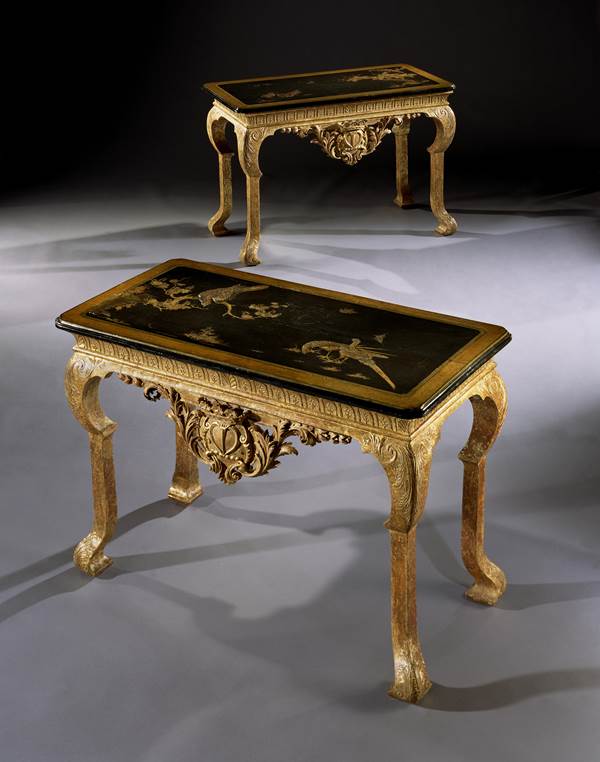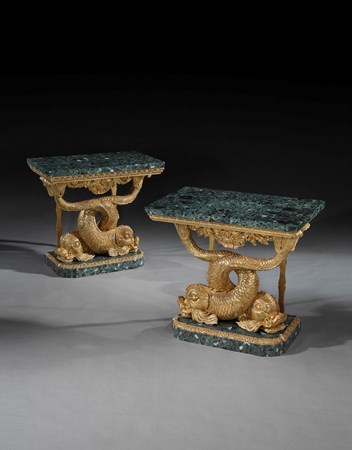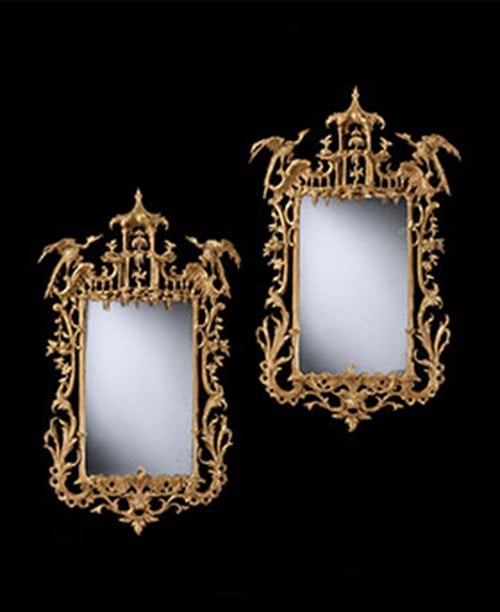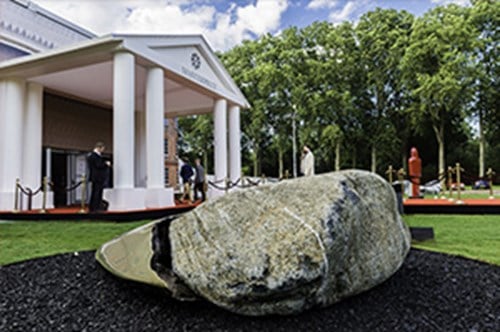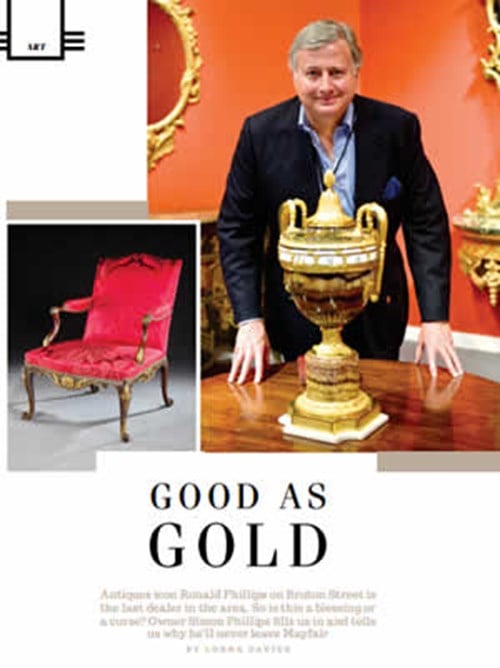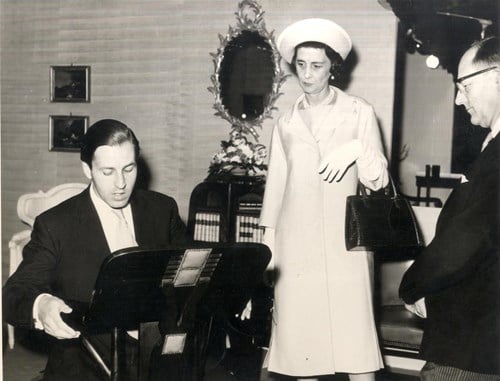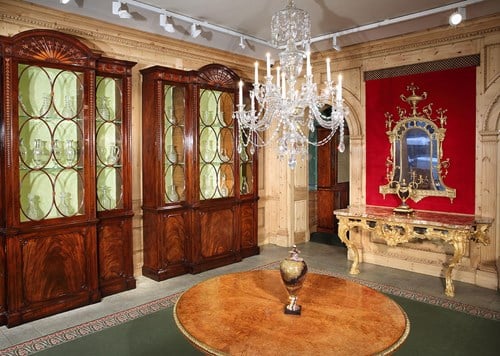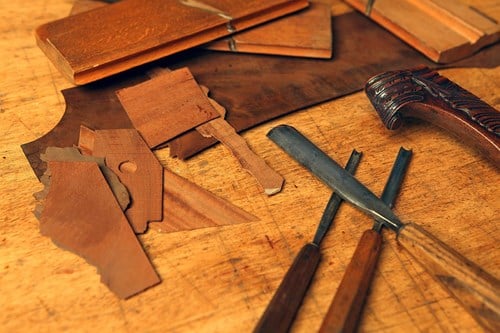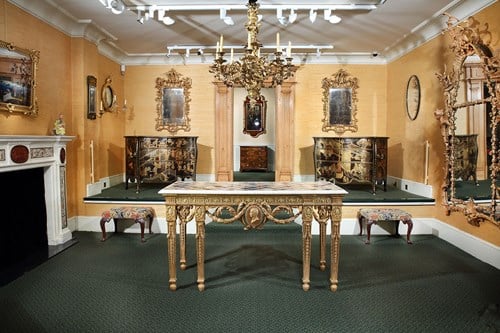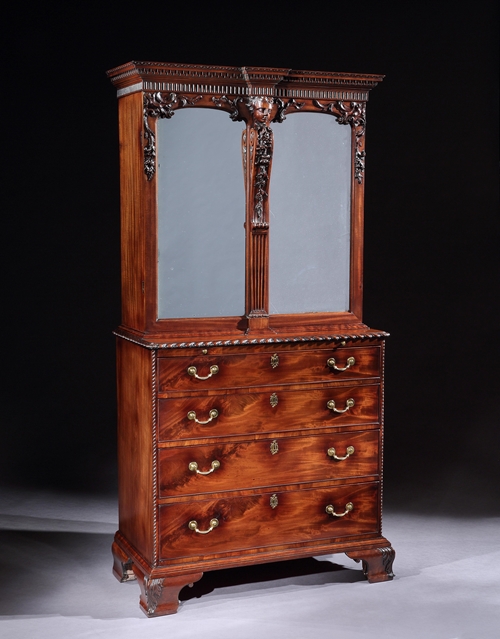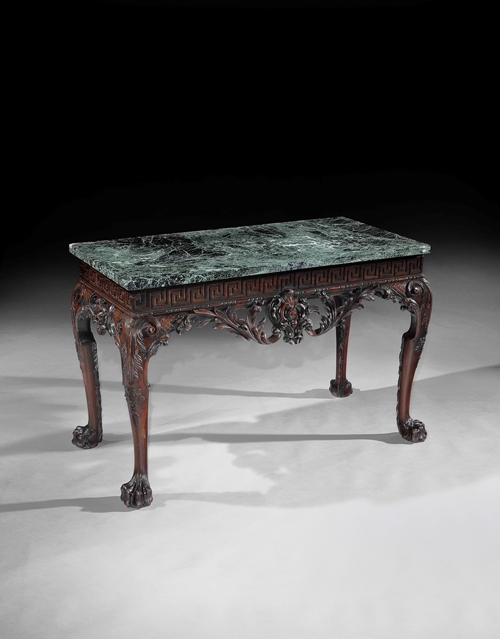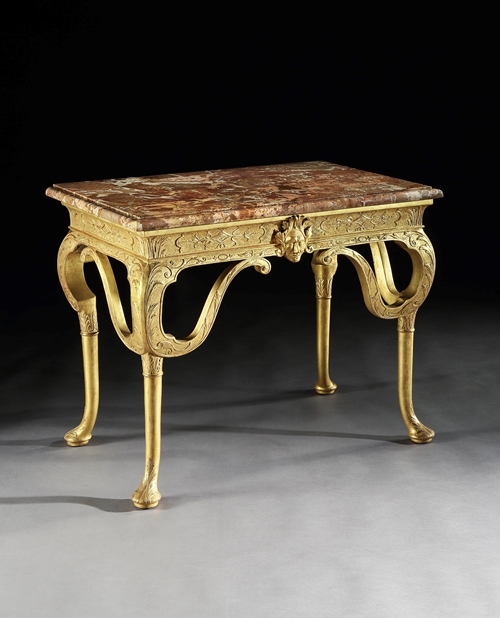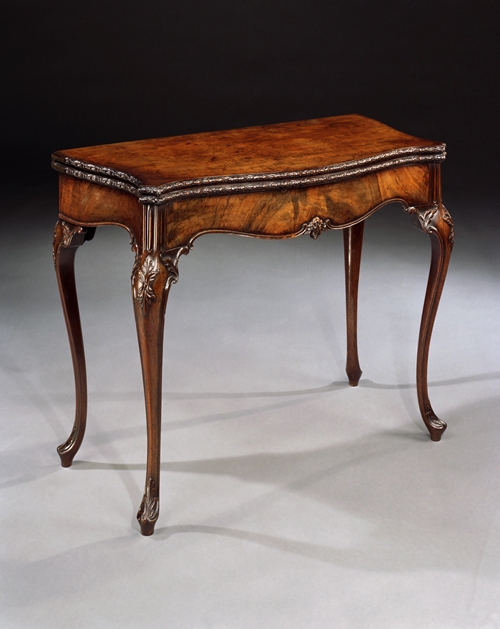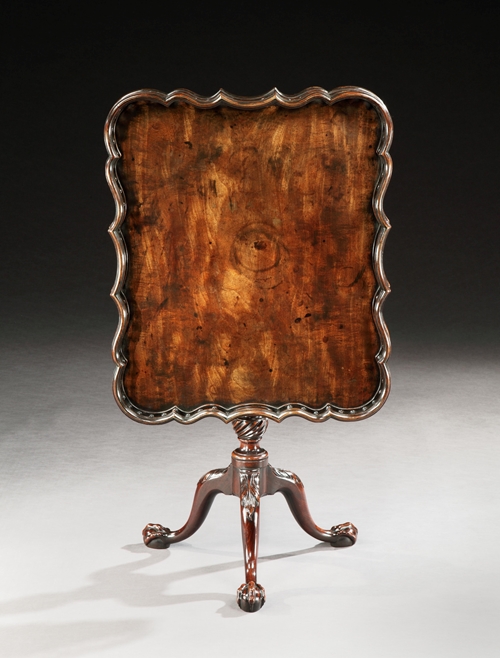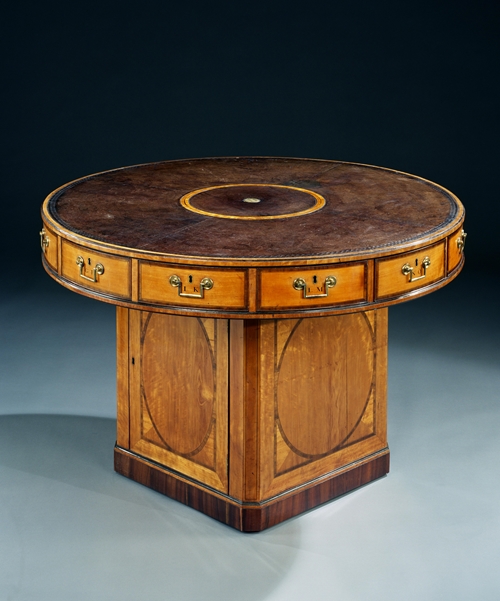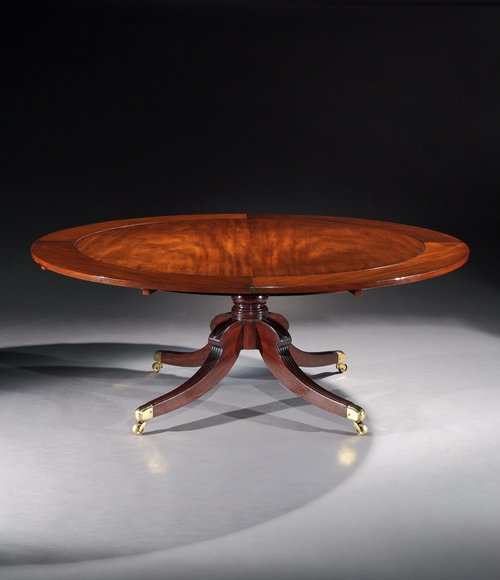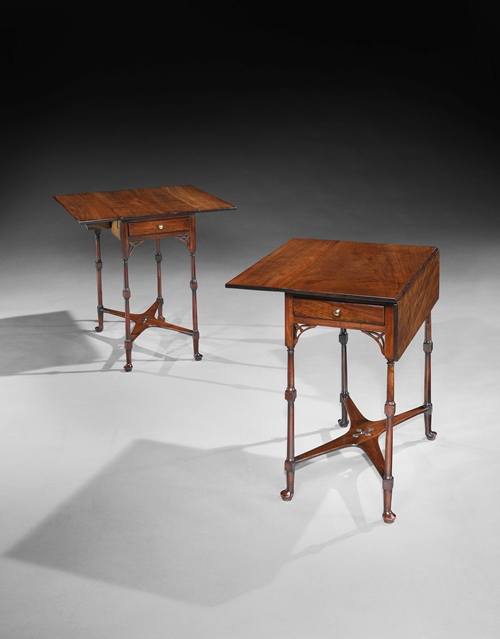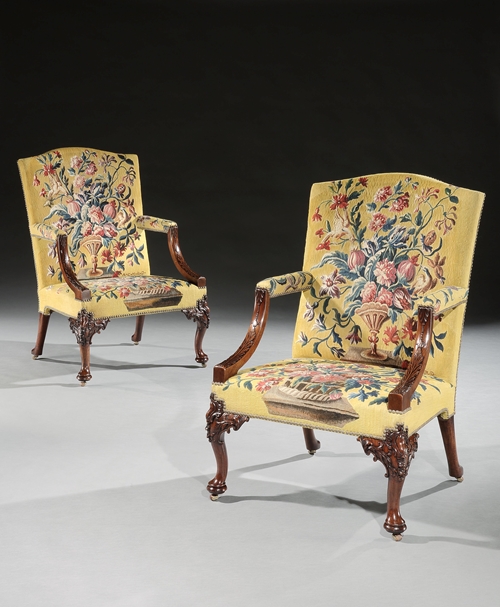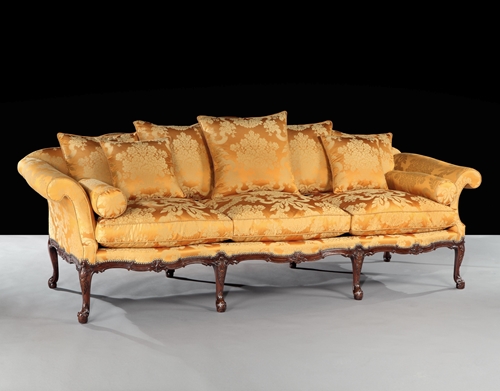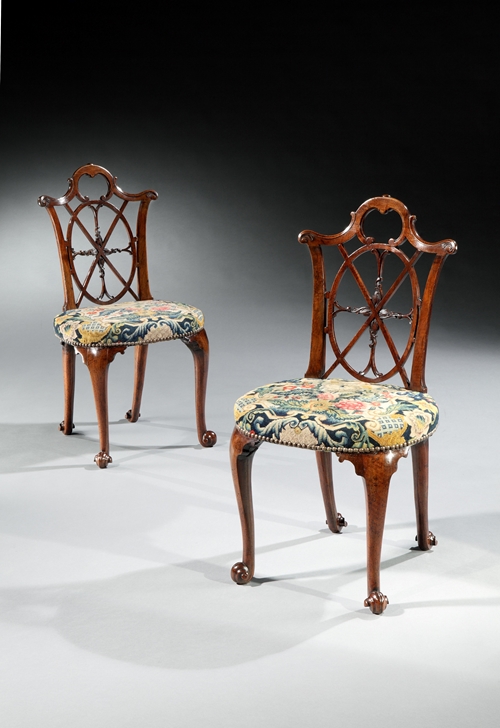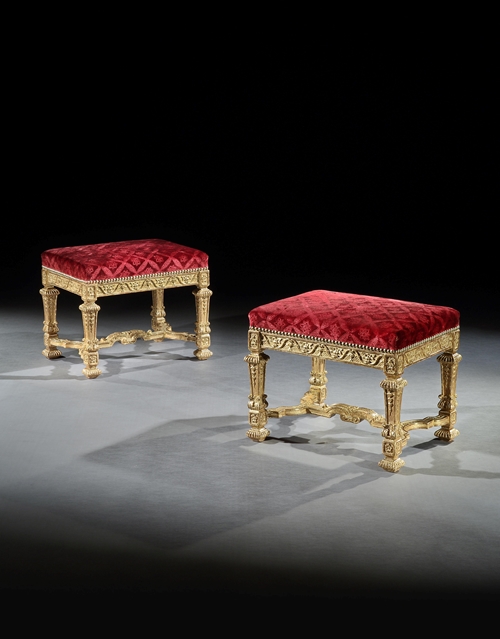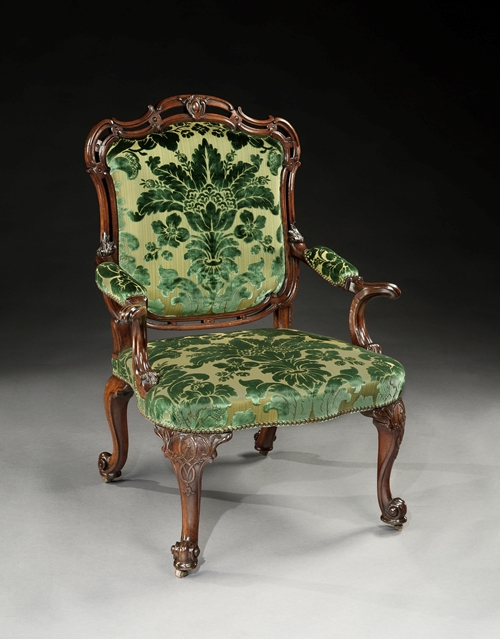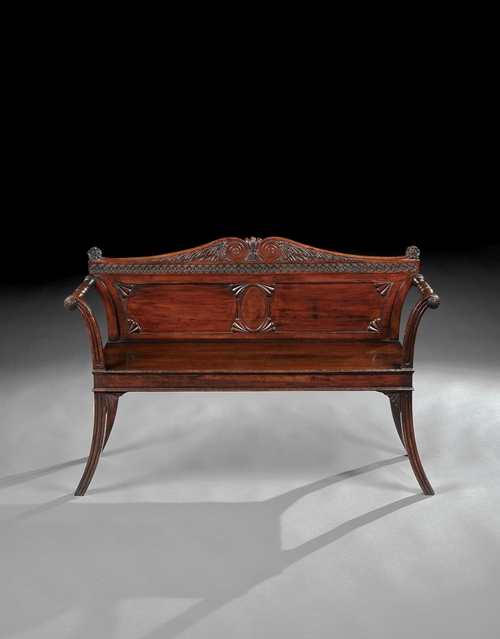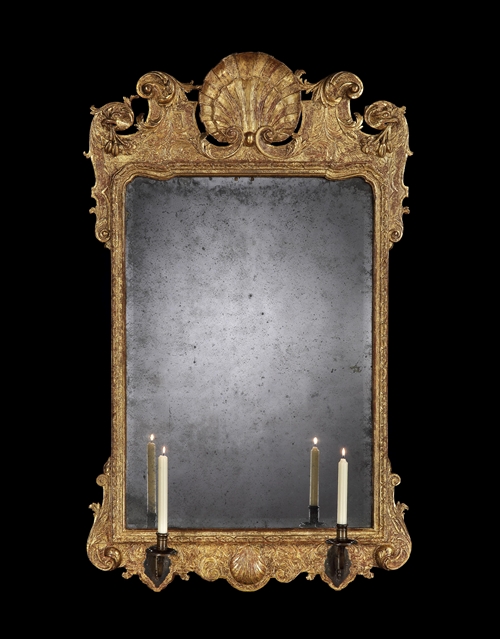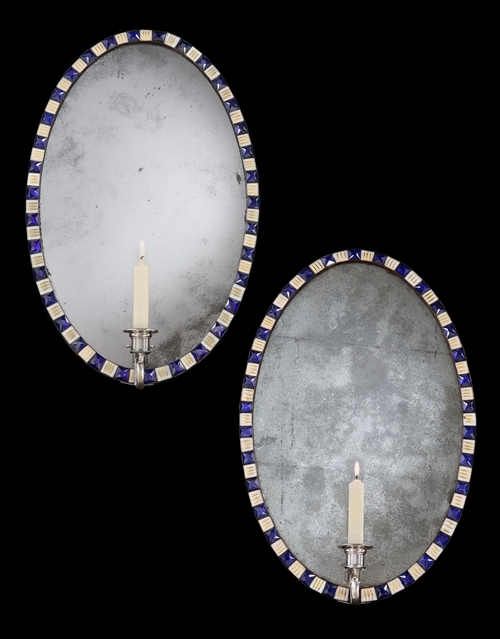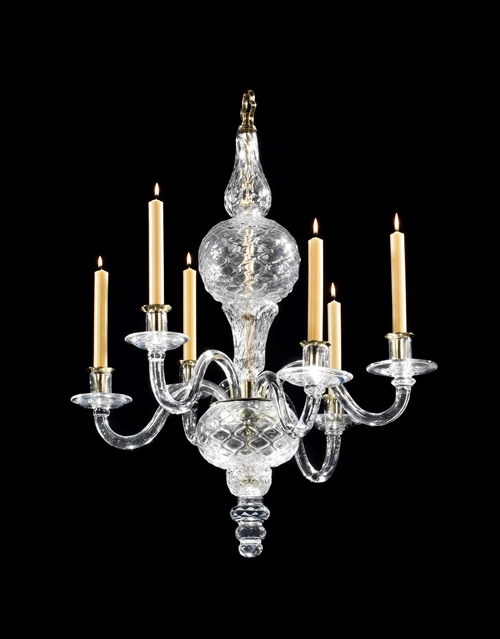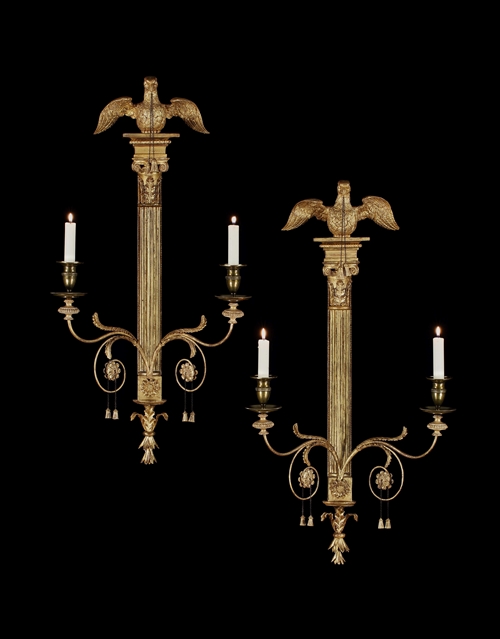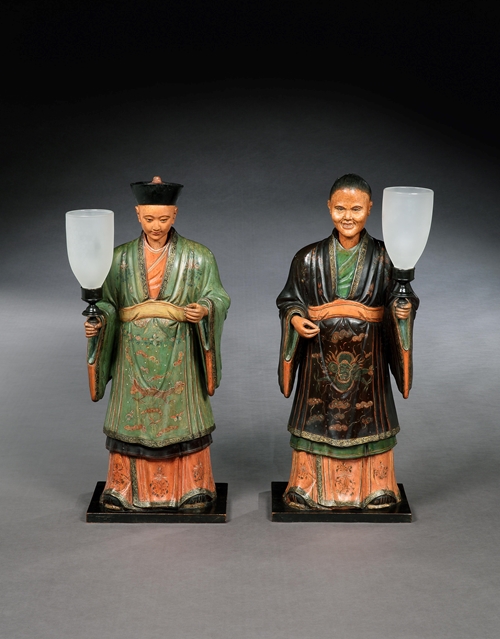A highly important pair of George I carved gesso and giltwood side tables, the rectangular Japanese black lacquer tops with re-entrant corners and moulded edge with a border framing a raised scene of exotic birds and trees, above a concave frieze with arched panels each framing an inverted harebell with a stylised leaf to each corner and centre, the shaped apron centred by a scrolled cartouche bearing a crest of a stylised buckle beneath a ducal coronet, raised on hipped legs with stylised carved acanthus decoration to the knee, the inverted feet with conforming foliate decoration.
This exceptional pair of tables seems certain to have been made by the royal furniture-maker James Moore the Elder (c. 1690-d. by 1743) for the immensely powerful 4th Duke of Newcastle-under-Lyme and 1st Duke of Newcastle-on-Tyne (1693-1768). The tables are exceptional not only for surviving in excellent condition, but also for being one of the earliest documented pairs from a small and highly important group of comparably sophisticated pieces.
The Attribution
The form of the tables closely follows the distinctive style of other examples of giltwood furniture made by Moore the Elder. The closest examples survive at Blenheim Palace, Oxfordshire, where a pair of giltwood tables supplied by James Moore to John Churchill, the 1st Duke of Marlborough (1650-1722), in about 1719 are displayed in the Bow Window Room. The Blenheim tables show remarkable similarities of scale, form and decoration, and display the cipher of the Duke of Marlborough within a closely related foliate cartouche on the apron. Interestingly, the tables are shown beneath a magnificent associated pair of giltwood pier glasses, also supplied by Moore, that give some indication of how the tables would perhaps have been displayed.
Further similarities may be seen in the treatment of the upper section of the Blenheim tables’ legs, which are decorated with almost identical foliate decoration, and also in the same unusual leg and distinctively shaped inward curving feet. The friezes are decorated with identical repeated arched divisions with the same foliate decoration to the corners.1 The unusual form to the legs is also seen in a set of giltwood chairs at Blenheim, on which the angular form is decorated with foliate decoration and a shaped cut to the underside. A similar unprovenanced table, also attributed to Moore, at the Treasurer’s House, York, also shares the same hipped knee and profile.
Moore is first recorded at Blenheim in 1705, the year that construction of the grea palace began, and he clearly established an unusually positive relationship with the notoriously difficult Duchess of Marlborough. Moore was in residence at the house from 1717 to 1724, acting as much more than a furniture-maker. Instead, he operated as a trusted surveyor, supervising the completion of the building works and helping to produce an interpretation of the designs for the building by the great English Baroque architect Sir John Vanbrugh (1664-1726) that more closely accorded with the Duchess’s desires. So emollient an effect did Moore have on his famously fractious employer that in a letter of 1719 to her friend Mrs. Boscawen, the Duchess described Moore as a ‘miracle of a man’.2
Moore’s involvement in supplying furniture for the great project at Blenheim is an indication of his considerable standing in court circles. At around the same time, he was also supplying furniture to the royal family, both to King George I and to the Prince and Princess of Wales (the future George II and Queen Caroline), which included the giltwood suites for Hampton Court supplied in September 1715.
The Patron and Commission
The crest displayed on the apron of the tables depicts a buckle beneath a ducal coronet, a device that appeared on many of the seals of the Pelham family and confirms the recipient of the original commission.4 At this date the head of the family was Thomas Pelham-Holles who, as the 4th Duke of Newcastle-under-Lyme and the recently created 1st Duke of Newcastle-on-Tyne, was one of the most prominent social and political figures of his day. He was clearly proud of his second dukedom and prominently displayed his coronet on these side tables and also perhaps on other furniture, judging by the crested gilt gesso chair shown in his portrait by Sir Godfrey Kneller (1646-1723).
His vast estates, stretching to holdings in eleven counties, provided a powerful background to a career in politics that began under George I and continued under George II, allowing Newcastle to rise to the position of Prime Minister twice between 1754 and 1762.
The closeness of Moore’s connections with Blenheim explains his involvement with the Duke of Newcastle, for in 1717 the Duke married the Marlboroughs’ granddaughter Lady Henrietta. The Duke of Newcastle was at this time engaged in his own extended involvement with Vanbrugh, whom he employed both in the internal refitting of Newcastle House, Lincoln’s Inn Fields, from 1714, and at Nottingham Castle, altering the interiors from 1719.
Surviving letters from the Duke of Newcastle to the Duchess of Marlborough crucially reveal that Moore too was employed at
Nottingham. Writing of the 'very noble' interiors of Nottingham Castle in December 1718, Newcastle remarked that, 'Mr. Moore, I must say does wonders. So I hope My Friend the Ds of M. will forgive my keeping him here.'5
However, by far the grandest project on which the Duke of Newcastle engaged Vanbrugh's services was at his great house at Claremont in Surrey. Newcastle had bought the architect in to create a scheme of ambitious additions and alterations. John Rocque's wings giving an impressive frontage, and showing Vanbrugh’s belvedere on the hill behind. (The belvedere is also visible through the open window in Kneller's portrait.) Surviving records reveal that these wings were added by 1717, and they would therefore have been furnished at about the same time.
The impression of Vanbrugh’s Claremont must have been closely comparable to that of Blenheim: a strikingly dramatic exterior, and an interior on a massive scale, composed of vast and largely uninterrupted expanses of wall.6 It seems highly likely that in seeking to furnish these extensive interiors the Duke of Newcastle also would have turned to Moore, a man who not only was pre-eminent in his field as a manufacturer of pieces to the royal family, but also had considerable experience in working with Vanbrugh’s interiors and, moreover, came with the express recommendation of his new grandmother-in-law, the Duchess of Marlborough. Vanbrugh was also on close terms with the famously extravagant Duke of Chandos, who certainly employed Moore to supply several suites of furniture for his great house of Canons, of which some pieces survive at Houghton Hall, Norfolk. The Duke of Chandos was evidently fascinated by the planned interiors at Claremont, and after dinner with him in 1718 Vanbrugh reported back to his patron at Claremont that ‘I have however done all I can to prevent his coming till ’tis quite done; that it may Stair in his face, And knock him downe at Once’.7
It seems possible, therefore, that the present tables not only represent an important extension of our knowledge of Moore’s
work and an insight into his involvement with the Duke of Newcastle, but also constitute a surviving fragment from one of the great lost interiors of early Georgian England, Claremont House, following its demolition in the early 1760s.
The Lacquer Tops
The taste for lacquer furniture had first developed along with trade with the Far East in the 16th century, prospering with the growing influence of the East India Company. Chinese and Japanese lacquer panels were imported to meet an increasing demand among fashionable collectors, and by the second part of the 17th century, European craftsmen, particularly those of France, were attaining remarkable results of their own. A pair of tables with similar lacquer tops was supplied by Gerrit Jensen (c. 1680-1715) to Queen Anne, a passionate collector of all things Oriental, for St. James’s Palace in 1704-1705.
These splendid tables remained in the collection of the family until June 1937, when they formed part of the sale of the property of the Earl of Lincoln, the eldest son of the 8th Duke of Newcastle, removed from their great house at Clumber Park. In that sale the tables are listed as 'A Pair of George I Giltwood Side Tables', with a description that reads: ‘The friezes carved with honeysuckle ornament, the aprons with pierced scrollwork and a ducal coronet, the tops inlaid with a panel of Japanese lacquer decorated with raised birds in gold on a black ground, on shaped legs. Each 3ft. 8 in. wide.'
They fetched the then significant sum of £81 18s and were sold to the leading London antique dealer of the day, Moss Harris & Sons.8
More research has yet to be done on the Newcastle archives, and it is hoped that further information to confirm the attribution will be forthcoming, as well as a further insight into the clearly magnificent lost interiors of Claremont House.
-
Provenance
Almost certainly supplied to Thomas Pelham-Holles, 4th Duke of Newcastle-under-Lyme and 1st Duke of Newcastle-on-Tyne, by James Moore the Elder for Claremont House, Surrey.
By descent to the Dukes of Newcastle at Clumber Park, Nottinghamshire, until sold by; Rt. Hon. Earl of Lincoln, Christie’s, 9th June 1937, lot 233.
Private collection.
Looking for something similar? YOU MAY ALSO LIKE
YOU HAVE RECENTLY VIEWED ITEMS
- CAN WE HELP YOU?
- +44 (0)20 7493 2341
- [email protected]
